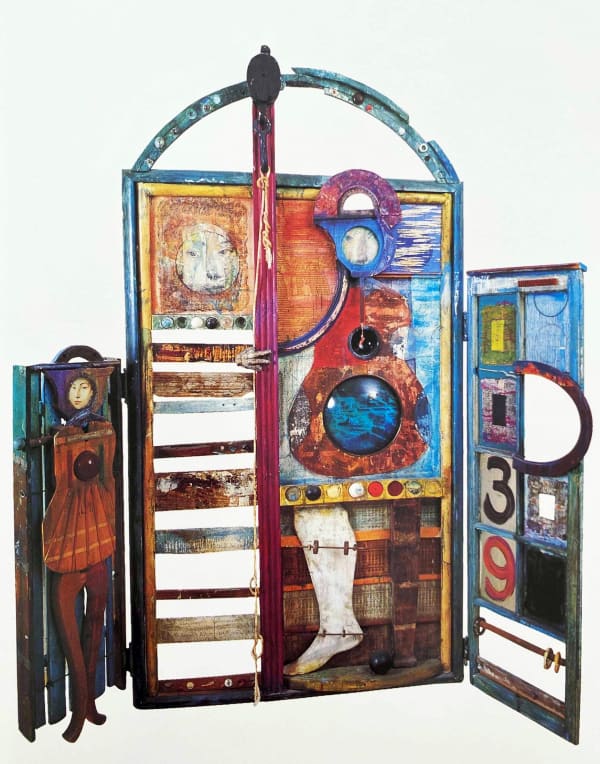-
A CONVERSATION WITH THE ARTIST
LYNDA ROSCOE HARTIGAN: Tell me where you think Totems come from, which ones might have come first and how you see them as a group. You were working on the Handkerchiefs but you somehow started working on Totems, which are much more three dimensional.
PATRICIA NIX: The Totems came about through working on Moonstone I had done these sort of totem shapes to put on the sides of Moonstone. I think of the Totems as interchangeable.
LRH: One of the questions I wanted to ask you is about the idea of individuality versus the entity. In some respects, you see each of these Totems as an item unto itself, but you give them greater credence if they are all grouped in that concept of the Totem Arrangement/ Altar.
Almost all of them are interchangeable. Why do you think that is? Why does that interchangeability appeal to you?
PN: Symbols are used over and over, to get them to interact. Then, because the Totems have unusual shapes, you can make new arrangements, new compositions. You can play with them and change the composition and the shapes.
LRH: When you built most of the Totems, and they're all primarily vertical, as most totems are, you have still managed to build compartmentalised compositions within them, squares built upon squares with capping elements. Is this something you did consciously?
PN: It's like the boxes, it's just like the compartments in the boxes.
LRH: Which reinforces their relationship to the boxes. When did you make the leap from the handkerchief paintings that are compartmentalised, is this something you did consciously?
PN: No. There was a time when I felt that I was through with the handkerchiefs, and that's when the totems started. So it was another way of not quite giving up the idea, but revitalising it. I wanted to take the handkerchiefs on until I had totally explored the ideas, had said everything I wanted to say about the handkerchiefs so I could be finished, complete.
LRH: What is it about the totems that makes you think that they are saying something about the handkerchiefs that the paintings did not?
PN: They are more sculptural than the paintings and you have the added dimension of being able to arrange them and rearrange them.
LRH: But what about the handkerchief as an entity itself? They obviously form the basis of the "square within the square" that represents the compartmentalisation of the totems. Why do the handkerchiefs work as an element for the totem?
PN: The handkerchiefs are actually just a vehicle that somehow makes my subconscious work. I can't explain it. It's like an object that you find that makes the box come together. The handkerchiefs are actually just a vehicle for the square; they add an extra psychological element and incongruity. Does that make sense?
LRH: Why is the handkerchief meaningful to you?
PN: When I first got the handkerchief pouch from my collector, I started making in little shallow trays, in squares, on which I was going to do collage. I had maybe them all over the floor with separate handkerchiefs in each one.
LRH: So, initially, the handkerchiefs were the source for small-scale works.
PN: As all of the squares were laid out on the floor, I began to think that this would be expected and the obvious thing for me to do. The trays were already there on the floor would never have thought of it except the squares were actually there to suggest it. I removed all of the handkerchiefs except one, and then I thought since my work is about repetition with variation, I should paint variations, to make composed units, and still introduce the element of collage. My first idea was to hang them separately, to have each square a separate piece. but I realized that it would be too difficult, the hanging, and they might get separated and sold and it wouldn't work, and so I began composing them in stationary frames.
LRH: As parts of a larger whole, in other words.
PN: Exactly. You can rearrange them indefinitely and that is exciting to me, especially the totems because of the sculptural things. I love the overall composition you can get.
LRH: That is a real push toward monumentality, something that one wouldn't necessarily associate with you, because of the small scale of the constructions. It demonstrates the possibilities for change and growth within your own approach to making work. Just because you have worked on a small scale or an easel-size scale with a lot of the paintings, that doesn't mean you have to be restricted to that. You have found very successful ways to enlarge the scale of your work.
PN: I guess the first one was the Moonstone and it happened very automatically. It went on for more than a year, and it was just a torment.
LRH: You found something in the street that really sparked Moonstone. What was it?
PN: The first thing that I got was the TV picture tube, the blue circle, that I found in the street. Then I had those wonderful white cast-iron legs, and I don't know, I think some of the stuff was laying on the floor, and I have always added guitars and musical instruments to my work. I started seeing this big figure, and it went from there.
-
 Moonstone. 1986-87 Mixed Media. 91'' x 87''
Moonstone. 1986-87 Mixed Media. 91'' x 87''

